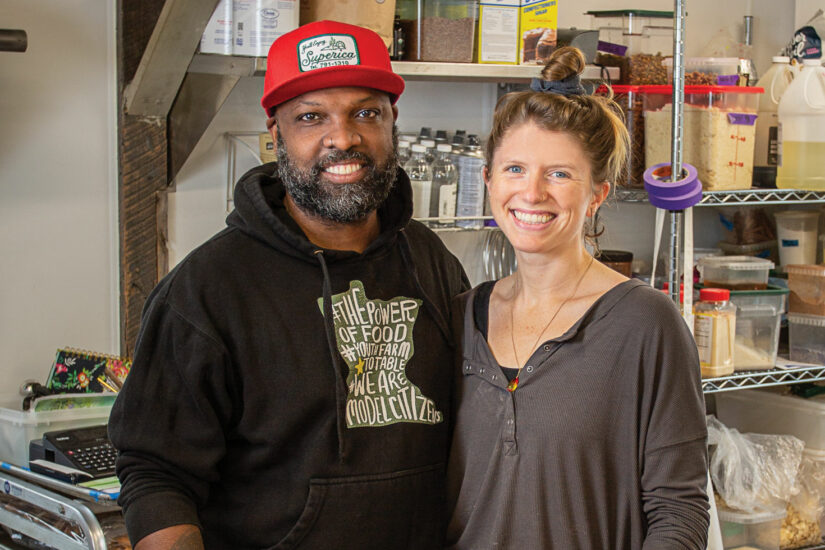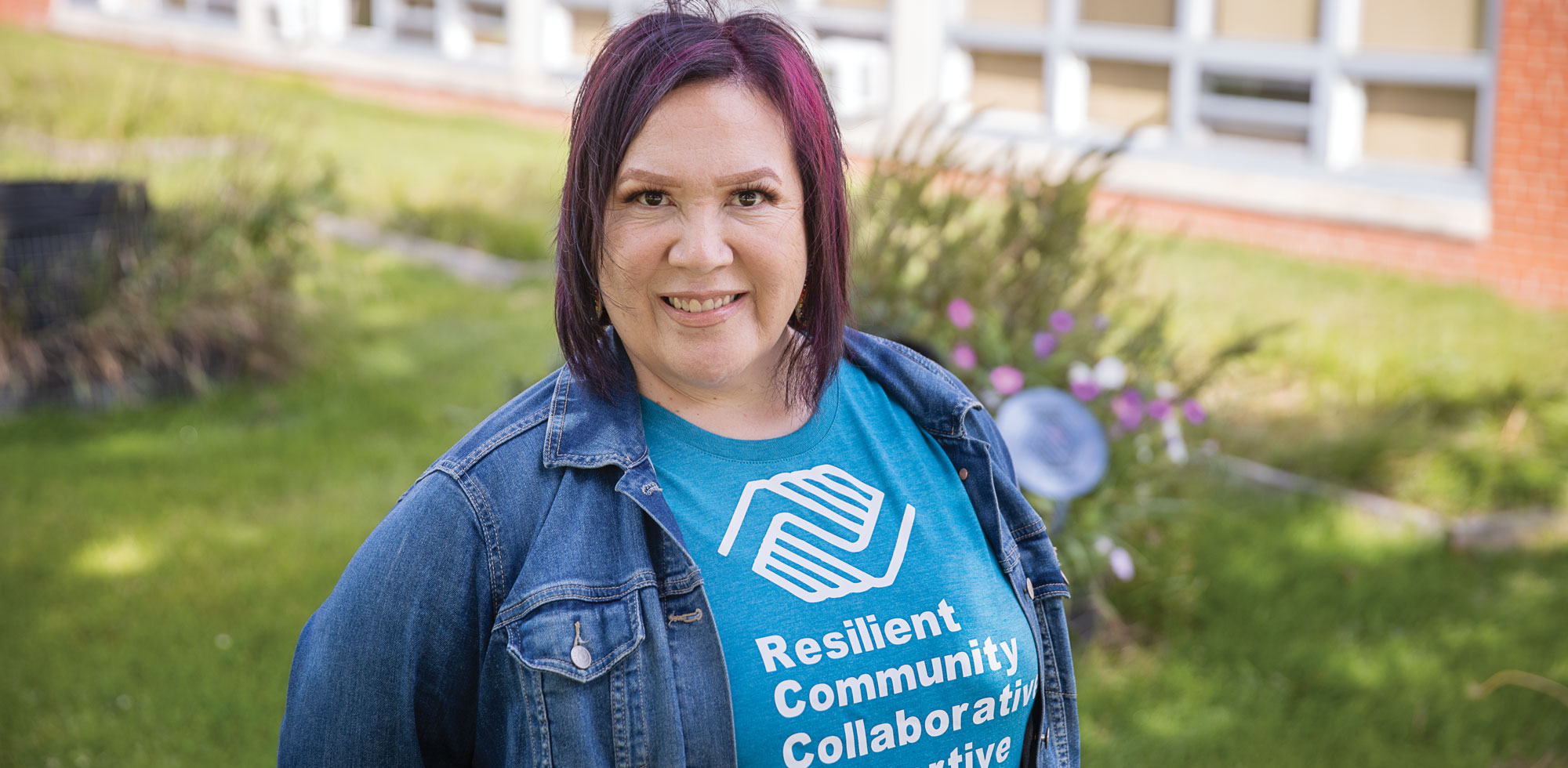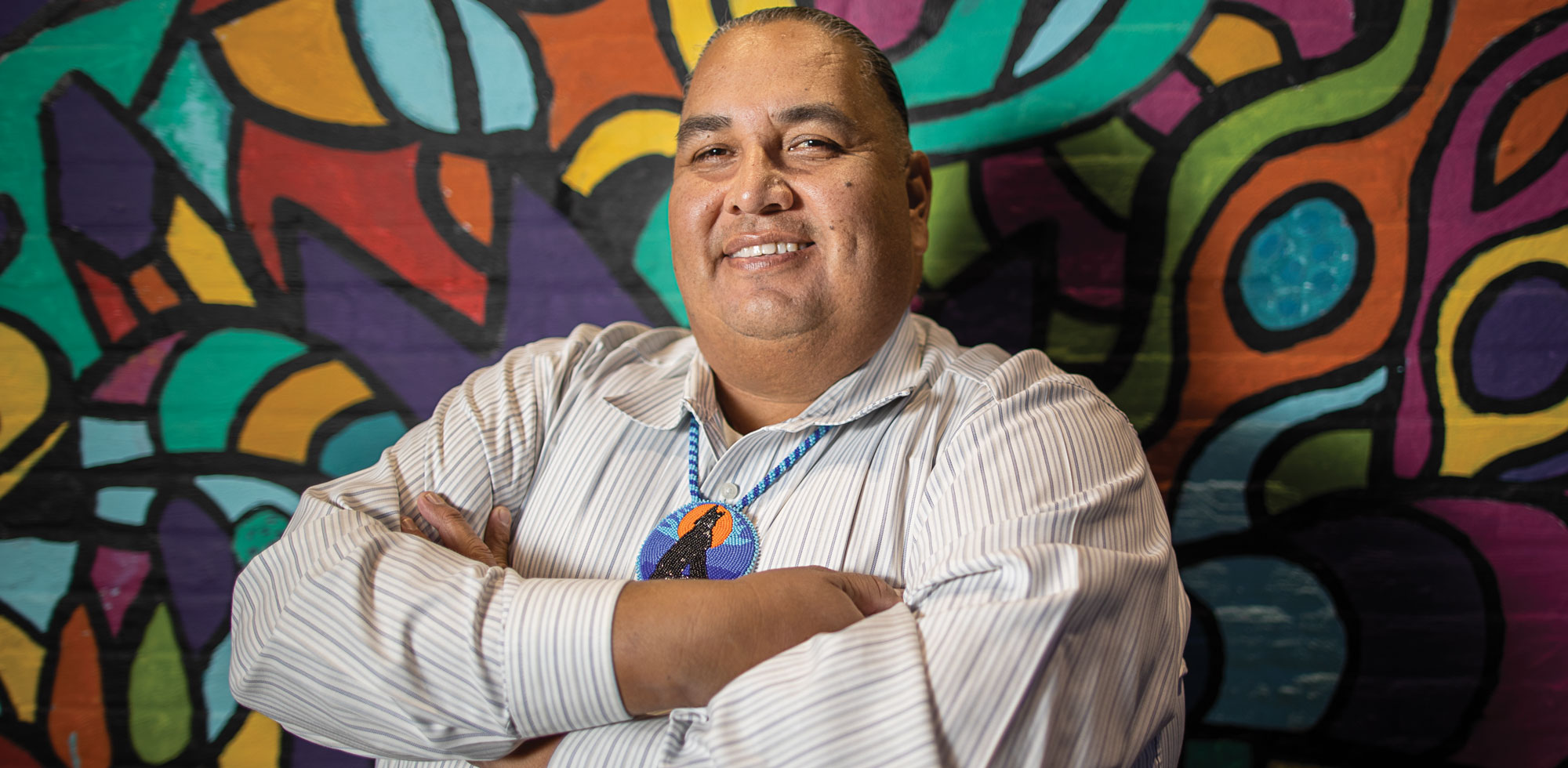
Ultimate Stress Test
The COVID-19 pandemic is the most challenging public health and economic crisis Central Minnesota has faced in a century. Here’s how the Initiative Foundation is supporting our region.
By Laura Billings Coleman | Photography by Michael Schoenecker and John Linn
Ever since they started dating, chefs Mateo Mackbee and Erin Lucas have been dreaming up ways to build connections and community with love, honey lavender pie and a legacy of Louisiana family recipes.
Veterans of the Twin Cities food scene, the couple relocated to Central Minnesota a few years ago, earning rave reviews for Model Citizen, their now-closed New London restaurant, which became a nonprofit that teaches kids about sustainable agriculture and cooking. They were planning to put down even deeper roots in the region in spring 2020 with an ambitious pair of projects in St. Joseph: Flour & Flower, an artisan bakery featuring Lucas’s trademark croissants and Scandinavian pastries, and Krewe, a Cajun/Creole restaurant inspired by Mackbee’s New Orleans heritage. Financed with help from family and friends, as well as a small business loan from the Initiative Foundation, the two eateries were gearing up for a grand opening in late March.
The novel coronavirus put a sudden halt to their plans.
The statewide stay-at-home restrictions forced restaurants, retailers and other small town businesses to close their doors—an economic shut-down that caused more than 80,000 Central Minnesotans to file for unemployment in the first two months of the pandemic. With no income and no obvious end in sight, simply finding flour, yeast and other fast-selling baking supplies became a challenge during those first months of social distancing. The bread oven and mixer Lucas ordered from Italy were even put into quarantine. “We’ve been in this business for awhile, so we tried to save with the idea that things don’t always go according to plan,” said Mackbee. “But these were problems we did not see coming.”
Main Street businesses and mom and pop shops make up an estimated 44 percent of the U.S. economy. They’re even more critical in Greater Minnesota, where 99.7 percent of local businesses are small businesses. “That’s why, at the start of the pandemic, the very first thing we did was to offer to defer loan payments for all of the small businesses in our portfolio,” said Matt Varilek, president of the Initiative Foundation. The move helped to create a little breathing room for 40 business owners, but it was just the start of an aggressive set of lending strategies and community grants the Initiative Foundation has launched since March to help buffer the economic strain and eventually move Central Minnesota’s economy into recovery.
Responding to major challenges in Central Minnesota’s rural and small town communities is built into the DNA of the Initiative Foundation, one of six regional entities that were created through a McKnight Foundation effort during the 1980s farm crisis to help build more diverse and resilient economies in Greater Minnesota. Over the last four decades, the region has seen its share of setbacks, recessions and natural disasters, but nothing on the scale of the COVID-19 pandemic, which has challenged regional response systems on every level, from health care and senior housing to food security and child care.

Continuing the Mission
Nonprofit organizations, which account for about 13 percent of Minnesota’s economy, have also been devastated by the pandemic. A study from the Minnesota Council of Nonprofits found that nearly $1 billion in nonprofit revenue disappeared in April, an income collapse that pushed nearly one-third of all of the state’s nonprofit employees out of a job. “Nonprofits don’t generally have a lot of cash reserves even in the best of times, and nearly all of the organizations we’re seeing have lost major sources of revenue because they can’t hold in-person fundraisers or conduct other programs that bring in revenue,” said Zach Tabatt, nonprofit development program officer for the Initiative Foundation. “But this loss of funding is happening at the same time that demand for health and social services is shooting up.”
To support the region’s nonprofits, the Initiative Foundation launched the Central Minnesota Emergency Relief and Recovery Fund to raise additional private dollars. The Foundation also championed a first-ever Give at Home campaign, a statewide online fundraising effort powered by GiveMN that helped secure more than $5 million for organizations and schools. To fill the growing needs that the COVID-19 crisis fueled, the Foundation took a new approach to discretionary grant-making. “We’ve traditionally tried to make investments for the long-term to build nonprofit capacity, workforce development, strategic planning and other things that will bear fruit over time, but we’ve set those typical guidelines aside and shifted to meeting the community’s basic food, shelter and medical needs in the near term,” said Varilek. “That’s not normally our style, but we felt it was justified in these circumstances.”
For instance, the Mille Lacs Band of Ojibwe and the Leech Lake Band of Ojibwe both received $15,000 grants to support food security within the tribal community, while Horizon Health in Pierz received a grant to provide food and technology connections for older adults living on their own during the pandemic. Grant funding has also helped nonprofits like Asamblea de Derechos Civiles launch new programs, including a Spanish language hotline based in St. Cloud that connects community members to food shelves, emergency medical care, COVID-19 testing and other relief programs.
At the same time, the Initiative Foundation allowed current nonprofit grantees more flexible funding terms, “giving them permission to toss out their work plans and concentrate on keeping the lights on,” said Varilek. That license has helped organizations like the Boys and Girls Club of the Leech Lake Area adapt to the rapidly changing landscape, including closing their traditional after-school operations in favor of working with tribal entities to provide child care options for families of essential workers.

“I’m really proud of the way we pivoted to provide help for so many families in need,” said the nonprofit’s executive director, Rebecca Graves. While keeping pace with new findings and changing protocols about face coverings and cleaning requirements has been a new challenge, she said, “our staff has been tremendous in spite of this huge transition. We’ve shifted gears in terms of how we’re providing service, but we’re still carrying out our mission in the
community.”
Resources and Relief
Central Minnesota’s travel and leisure industry has also been significantly affected by the coronavirus crisis; nearly 46 percent of workers in the accommodations, food service and recreation sectors applied for unemployment benefits between March and May. “The Brainerd Lakes region’s hospitality market got hit hard in what was supposed to be our peak summertime season,” said Jeff Wig, Initiative Foundation vice president for entrepreneurship. Other sectors that have suffered through the pandemic are mining (with 33 percent of the workforce applying for unemployment by the end of May), construction (29 percent), and health care and social assistance (26 percent).
While those unemployment figures are without precedent, they might have been much worse were it not for the 13,700 Minnesota businesses that received financial support from the federal Paycheck Protection Program (PPP) launched in the wake of COVID-19. The program supported an estimated 711,000 jobs across Minnesota, with funding that is partially forgivable for many businesses. “A lot of small business owners in our region are very hesitant about taking on more debt, or have told us they’re keeping the money in the bank and are afraid to spend it,” Wig said. “That tells us we need to provide relief that isn’t just in the form of more loans.”
Last June during the special session, the Minnesota Legislature approved $62.5 million for Small Business Relief Grants. Half of that money is going to Greater Minnesota via a lottery-style selection process that is managed by the Minnesota Department of Employment and Economic Development (DEED). The Minnesota Initiative Foundations are now managing the administration and distribution of these funds in their respective regions.
“In a typical year we might award about $2.5 million in grants,” said Varilek. “But because of this crisis, we expect to be distributing up to $7.8 million in grants to Central Minnesota businesses this fall alone.” To help small businesses understand how these grants work, the Initiative Foundation produced multi-language (English, Somali and Spanish) videos, which were shared with the region’s immigrant business communities.
While it’s too soon to know how these strategies will impact the region, early signs suggest that many small businesses are already starting to rebound. Barber shops and hair salons are booked again for socially-distanced services. Family farms and local food purveyors reported surprising gains during the summer, as consumers are discovering the benefits of buying directly from growers. Of the 130 businesses that were given loan deferrals by the foundation during the worst of the pandemic crisis, Wig reports that not a single business defaulted on their payments in July.
That includes Mackbee and Lucas, who succeeded in opening the Flour & Flower Bakery in St. Joseph for take-out orders in June. Their pastries, breads and pies are so popular with the College Avenue crowd that their inventory is typically sold out by 10 a.m. The couple opened Krewe not long after, landing on the front of The New York Times food section in a feel-good story about their partnership, which is St. Joe’s first Black-owned business. “We’re getting so much support from the community it’s kind of amazing,” Mackbee said on a weekday in July, while he was trying to locate more patio furniture to accommodate guests who want to sit outside. With required reservations, face masks and social-distancing standards that keep the restaurant at 50-percent capacity, there’s no question that COVID-19 is forcing entrepreneurs like Mackbee to find new ways of doing business. “But if we can keep moving forward from here, we know there are going to be better days.”

“Everyone’s eyes are opened to what’s always been under the surface.”
In the aftermath of the George Floyd killing, Central Minnesota reckons with the role race plays in our society.
By Laura Billings Coleman
U.S. News and World Report recently ranked Minnesota one of the top three states in the nation for economic opportunity and upward mobility. But access to opportunity across racial and ethnic groups is taking on new urgency in the wake of the COVID-19 crisis and the growing Black Lives Matter movement.
African Americans, immigrants, indigenous people and other communities of color have been especially hard hit by the pandemic, with both higher rates of serious infections and hospitalizations, and disproportionate jobless rates. A recent report from DEED found that half of African Americans workers in Minnesota have filed for unemployment since mid-March—double the jobless rate for white workers. In May, the police killing of George Floyd in Minneapolis brought these persistent disparities into stark relief, fueling protests around the world, and a deep reckoning for the state of Minnesota, where racial inequities are among the worst in the country.
“What’s happened in the wake of the pandemic has been an unprecedented stress test for the region that has revealed many of Central Minnesota’s strengths as well as the urgent work we still have to do, especially when it comes to widening access to opportunity and equality for people of color,” said Initiative Foundation President Matt Varilek. “The lesson of this crisis is that we’re seeing how interdependent we all are, and how critical it is to ensure that everyone in our region is included in a strong recovery.”
Other community leaders agree. “COVID was already hard on people,” said Buddy King, one of the founders of Higher Works Collaborative, a nonprofit focused on connecting St. Cloud’s African American community with health, housing and employment resources. “But then you throw on the George Floyd murder and suddenly everyone’s eyes are opened up to what’s always been under the surface. It’s no longer a hidden thing, which may be why this moment in time feels different.”
King is a community partner to the Initiative Foundation’s Enterprise Academy, a program that provides technical training, lending assistance and business plan mentorship to entrepreneurs from underserved communities. It’s critical work in Minnesota, where racial disparities have long been among the nation’s worst, with nearly 32 percent of Black people in the state living in poverty—a rate four times that of white people. Though nonwhite workers have been vital to Central Minnesota’s economic growth since 2000, filling an additional 10,633 jobs in the region, or about 18.4 percent of new jobs added, according to a 2016 DEED report, people of color haven’t participated in the benefits of that growth at the same rate as whites. African Americans have the highest unemployment rate in the region—16 percent, which is more than three times the rate for whites. Meanwhile, median income for Black households in Central Minnesota was $20,774—less than a third that of white households. Similarly, poverty rates among Native Americans and Latinx in the region are more than double that of their white counterparts.
Charles Black Lance, Trio Programs Director at Central Lakes College and a Trustee of the Initiative Foundation, says the current moment has highlighted—sometimes painfully—how much work there is still to be done to advance diversity and equity in Central Minnesota.
Talking truthfully about white privilege and systemic racism is not simple in communities that are overwhelmingly white, said Black Lance, who is a member of the Brainerd Public School board and an enrolled member of the White Earth Nation. He says his big frame and long black hair have made him a target for racial profiling in the past. This summer, when Black Lives Matter supporters in Brainerd clashed with protesters with Confederate flags, “It was surreal for me—I know people on both sides, I love people on both sides. But sitting down even when we have differences is what democracy is all about,” he said. “There are going to be growing pains, but I’m willing to go through the discomfort if it means leaving something different for our youth.”
COVID-19 IMPACT UPDATE
Since the onset of the pandemic …
- 1,000+ BUSINESSES financially supported
- $8.6M+ GRANTS
- $7.85 million in small business relief grants
- $295,000 to childcare, early childhood;
- $203,000 to nonprofits
- $250,400 via Partner Fund relief efforts
- $4M+ LOANS
- $1.2 million in new loans;
- $2.85 million in adjusted loan terms